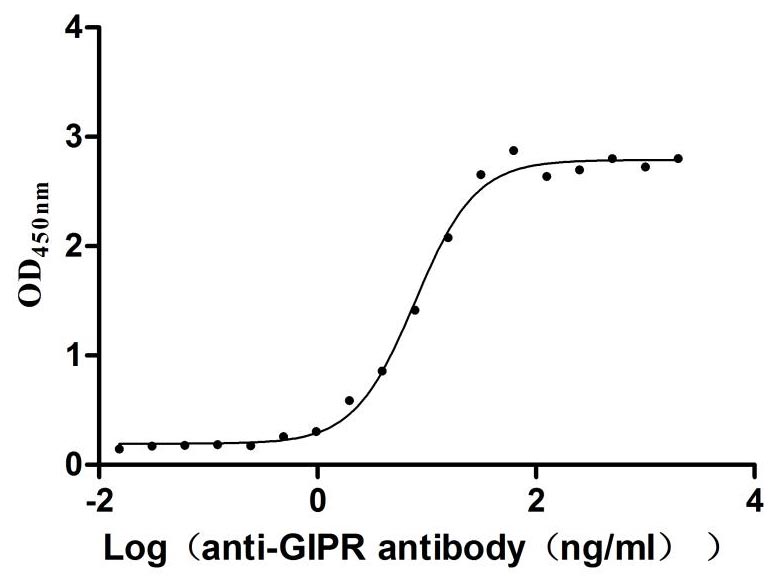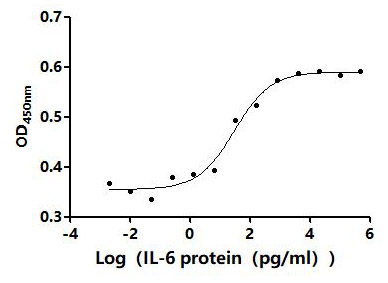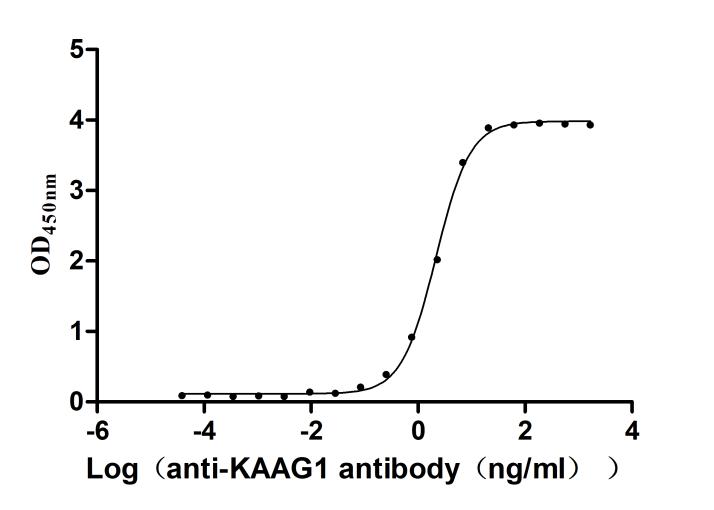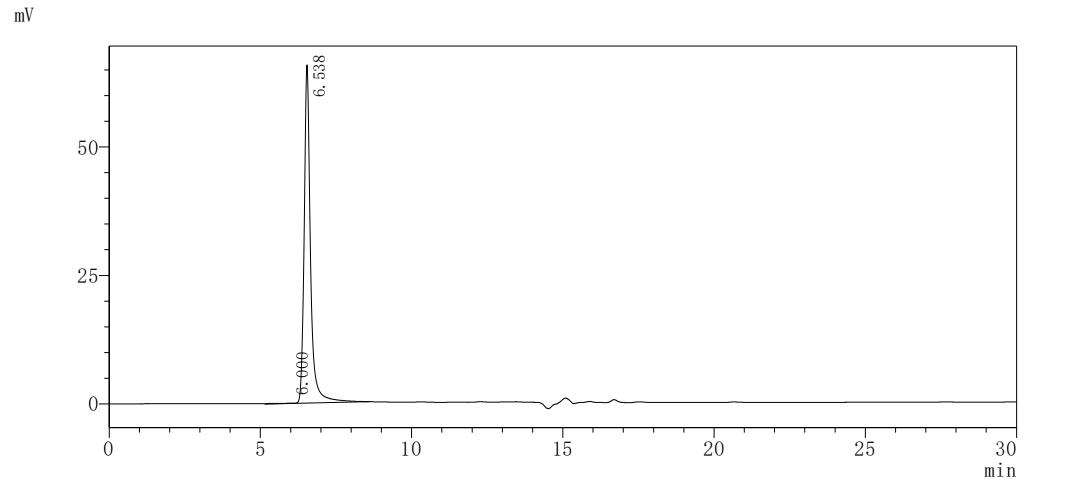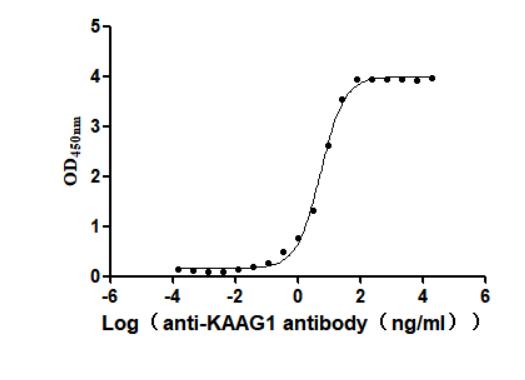Recombinant Mouse Voltage-dependent L-type calcium channel subunit alpha-1C (Cacna1c), partial
In Stock-
中文名稱:Recombinant Mouse Voltage-dependent L-type calcium channel subunit alpha-1C (Cacna1c), partial
-
貨號(hào):CSB-EP5127MO3
-
規(guī)格:¥1836
-
圖片:
-
其他:
產(chǎn)品詳情
-
純度:Greater than 85% as determined by SDS-PAGE.
-
生物活性:Not Test
-
基因名:
-
Uniprot No.:
-
別名:Calcium channel, L type, alpha-1 polypeptide, isoform 1, cardiac muscle;MELC-CC;Mouse brain class C;MBC;Voltage-gated calcium channel subunit alpha Cav1.2
-
種屬:Mus musculus (Mouse)
-
蛋白長(zhǎng)度:Partial
-
來(lái)源:E.coli
-
分子量:82.6 kDa
-
表達(dá)區(qū)域:1689-2139aa
-
氨基酸序列AASEDDIFRRAGGLFGNHVTYYQSDSRGNFPQTFATQRPLHINKTGNNQADTESPSHEKLVDSTFTPSSYSSTGSNANINNANNTALGRFPHPAGYSSTVSTVEGHGPPLSPAVRVQEAAWKLSSKRCHSRESQGATVNQEIFPDETRSVRMSEEAEYCSEPSLLSTDMFSYQEDEHRQLTCPEEDKREIQPSPKRSFLRSASLGRRASFHLECLKRQKDQGGDISQKTALPLHLVHHQALAVAGLSPLLQRSHSPTTFPRPCPTPPVTPGSRGRPLRPIPTLRLEGAESSEKLNSSFPSIHCSSWSEETTACSGSSSMARRARPVSLTVPSQAGAPGRQFHGSASSLVEAVLISEGLGQFAQDPKFIEVTTQELADACDMTIEEMENAADNILSGGAQQSPNGTLLPFVNCRDPGQDRAVAPEDESCAYALGRGRSEEALADSRSYVSNL
Note: The complete sequence may include tag sequence, target protein sequence, linker sequence and extra sequence that is translated with the protein sequence for the purpose(s) of secretion, stability, solubility, etc.
If the exact amino acid sequence of this recombinant protein is critical to your application, please explicitly request the full and complete sequence of this protein before ordering. -
蛋白標(biāo)簽:C-terminal 6xHis-GFP-tagged
-
產(chǎn)品提供形式:Liquid or Lyophilized powder
Note: We will preferentially ship the format that we have in stock, however, if you have any special requirement for the format, please remark your requirement when placing the order, we will prepare according to your demand. -
緩沖液:If the delivery form is liquid, the default storage buffer is Tris/PBS-based buffer, 5%-50% glycerol. If the delivery form is lyophilized powder, the buffer before lyophilization is Tris/PBS-based buffer, 6% Trehalose.
-
復(fù)溶:We recommend that this vial be briefly centrifuged prior to opening to bring the contents to the bottom. Please reconstitute protein in deionized sterile water to a concentration of 0.1-1.0 mg/mL.We recommend to add 5-50% of glycerol (final concentration) and aliquot for long-term storage at -20℃/-80℃. Our default final concentration of glycerol is 50%. Customers could use it as reference.
-
儲(chǔ)存條件:Store at -20°C/-80°C upon receipt, aliquoting is necessary for mutiple use. Avoid repeated freeze-thaw cycles.
-
保質(zhì)期:The shelf life is related to many factors, storage state, buffer ingredients, storage temperature and the stability of the protein itself.
Generally, the shelf life of liquid form is 6 months at -20°C/-80°C. The shelf life of lyophilized form is 12 months at -20°C/-80°C. -
貨期:3-7 business days
-
注意事項(xiàng):Repeated freezing and thawing is not recommended. Store working aliquots at 4℃ for up to one week.
-
Datasheet & COA:Please contact us to get it.
靶點(diǎn)詳情
-
功能:Pore-forming, alpha-1C subunit of the voltage-gated calcium channel that gives rise to L-type calcium currents. Mediates influx of calcium ions into the cytoplasm, and thereby triggers calcium release from the sarcoplasm. Plays an important role in excitation-contraction coupling in the heart. Required for normal heart development and normal regulation of heart rhythm. Required for normal contraction of smooth muscle cells in blood vessels and in the intestine. Essential for normal blood pressure regulation via its role in the contraction of arterial smooth muscle cells. Long-lasting (L-type) calcium channels belong to the 'high-voltage activated' (HVA) group.
-
基因功能參考文獻(xiàn):
- miR-137 regulated the expression of the CACNA1C gene. PMID: 30102687
- The Shank3/F model, and to a much lesser extent, the Shank3/J and Cacna1c models, showed hypoactivity and a general anxiety-like behavior triggered by external stimuli which pervaded social interactions. PMID: 28753255
- Proteolytic cleavage and phosphorylation of alpha1C subunit are not required for adrenergic regulation of CaV1.2 in the heart. PMID: 28784807
- The data of this study illustrated an important role of CaV1.2 in fear extinction and the synaptic regulation of activity within the amygdala. PMID: 29038219
- Cav1.2 mutation associated with Timothy syndrome has pleiotropic effects on the ascending serotonin system. PMID: 28921675
- Cardiac specific expression of the mutated Cav1.2PKA_P2(-/-) gene reduces Cav1.2 alpha1c protein concentration, calcium current (ICa), and the beta-adrenergic stimulation of L-type ICa in cardiomyocytes. PMID: 28778765
- the significant decrease or absence of exon 33-containing CaV1.2 channels is potentially proarrhythmic in the heart. PMID: 28490495
- Findings suggest that REDD1 in cacna1c heterozygous mice may influence depression-related behavior via regulation of the FoxO3a pathway. Study identified the prefrontal cortex as a key brain region in which cacna1c mechanisms through previously unidentified, novel molecular pathways contribute to depression-related behavior. PMID: 27922594
- Normal regulation of CaV1.2 channels by phosphorylation of Ser1700 in cardiomyocytes is required for cardiovascular homeostasis and normal physiological regulation in vivo. PMID: 27864509
- Cacna1c reduction causally predisposes to the maladaptive outcomes of social stress. PMID: 28165117
- Deletion of psychiatric risk gene Cacna1c impairs hippocampal neurogenesis PMID: 28230278
- A novel and selective role was found for the Cav1.2 channel in the hippocampus that mediates extinction of cocaine conditioned place preference. PMID: 29089442
- Findings indicate tissue-specific differences in L-type calcium channel CaV1.2 regulation and suggest that it may be possible to design therapies to target this channel in specific tissues. PMID: 28119457
- Data indicate a subpopulation of the CaV1.2 channel pore-forming subunit (alpha1C) within nanometer proximity of protein kinase A (PKA) at the sarcolemma of murine and human arterial myocytes. PMID: 28119464
- S1928A KI mice failed to induce long-term potentiation in response to prolonged theta-tetanus (PTT-LTP), a form of synaptic plasticity that requires Cav1.2 and enhancement of its activity by the beta2-adrenergic receptor (beta2AR)-cAMP-PKA cascade. PMID: 28119465
- Cav1.2 can modulate oligodendrocyte maturation in the demyelinated brain and is critical for remyelination. PMID: 28899915
- CaV1.2 knock-out mice exhibited normal acquisition and recall of the location of the hidden platform in a standard Morris water maze, but were unable to form a memory of when the number of available spatial cues was restricted. Within the dentate gyrus, pan-neuronal deletion of CaV1.2 resulted in decreased cell proliferation and the numbers of doublecortin-positive adult-born neurons. PMID: 27957527
- The present study shows that ANO1 and CavL play a central role in the generation of slow waves, phasic contractions and tone in the internal anal sphincter and that this pathway can occur in the absence of stretch PMID: 28054347
- Cacna1c haploinsufficient mice lack normal sensitivity to inhibition of the dopamine transporter. Cacna1c is crucial for normal behavioral responses to DA stimulants. PMID: 28186690
- Data (including data from studies using transgenic/knockout mice) suggest Cacna1c is involved in specific aspects of learning (behavioral strategies for increasing reward rate); majority of Cacna1c knockout mice manage to increase reward feedback across trials but appear to do so by adapting outcome-based behavioral strategy, while majority of control mice appear to adopt experimentally intended cue-association behavior. PMID: 28604818
- This study showed that Cav1.2, but not Cav1.3, L-type calcium channel subtype mediates nicotine-induced conditioned place preference in mice. PMID: 28185965
- We report that the protein densin-180 is highly enriched at excitatory synapses in the brain and enhances the cell surface trafficking and postsynaptic localization of Cav1.2 L-type Ca(2+) channels in neurons. This interaction promotes coupling of Cav1.2 channels to activity-dependent gene transcription. PMID: 28363979
- These results indicate that Cav1.2 modulates oligodendrocyte development and suggest that Ca(2+) influx mediated by L-type voltage-operated Ca(2+) channels inoligodendrocyte progenitor cells is necessary for normal myelination PMID: 27798140
- The authors show that phosphorylation of S1928 displaces the beta-2 adrenergic receptor from Cav1.2 upon beta-adrenergic stimulation rendering Cav1.2 refractory for several minutes from further beta-adrenergic stimulation. PMID: 27103070
- findings suggest that Hap1 is important for insulin secretion of pancreatic beta-cells via regulating the intracellular trafficking and plasma membrane localization of Cav1.2, providing new insight into the mechanisms that regulate insulin release from pancreatic beta-cells. PMID: 27624941
- these data indicate for the first time a functional interaction between Orai1, TRPC1, and CaV1.2 channels in Vascular Smooth Muscle Cells, confirming that upon agonist stimulation, vessel contraction involves Ca(2+) entry due to co-activation of Orai1- and TRPC1-dependent store-operated Ca(2+) channels and L-type Ca(2+) channels. PMID: 27535226
- These findings suggest that Trpc3 is a mediator of pathologic cardiac hypertrophy not only through mediating part of the Ca(2+) influx, but also through control of CaV1.2 expressions. PMID: 27522668
- K(ATP) channel gain-of-function leads to increased myocardial L-type Ca(2+) current and contractility in Cantu syndrome. PMID: 27247394
- This study demonstrate a role of Cav1.2 in regulating survival of young hippocampal neurons in living mice by studying both forebrain-Cav1.2 cKO mice. PMID: 27066530
- Results provide evidence that decreased Cacna1c expression has a protective role in the modulation of age-related cognitive declines, and support an interaction between Cacna1c, sex and memory impairment PMID: 25989111
- Both the extracellular PFXYD motif and the transmembrane domain of PLM but not the cytoplasmic tail were necessary for regulation of peak L-type Ca(2+) current amplitude. PMID: 25918050
- Treatment of MSC with BMP4 caused a significant increase in expression of Cav1.2, a delay in expression of Cav1.1, and a reduction in the duration of calcium transients when extracellular calcium was removed PMID: 25277766
- data suggest that miR-103 inhibits osteoblast proliferation mainly through suppression of Cav1.2 expression under simulated microgravity condition PMID: 25868801
- The down-regulation of Cav1.2 expression and the inhibition of LTCCs caused by mechanical unloading in osteoblasts are partially due to miR-103 up-regulation. PMID: 25627864
- Ammonium-induced deregulation of astroglial Ca(2+) signalling, is, in part, associated with upregulation of Cav1.2 L-type calcium channels PMID: 25846713
- Methamphetamine alters DNA methylation, expression, and protein abundance of CACNA1C. PMID: 26307267
- demonstrate for the first time that both Cav1.2 and Cav1.3 are necessary for neuronal survival but are differentially required for the biophysical properties of neurons PMID: 26242732
- Our findings reveal that the intra-SR protein Casq2 is largely responsible for the phenomenon of SR Ca(2+) release refractoriness in murine ventricular myocytes. PMID: 25758429
- results suggest the involvement of Cacna1c (Cav1.2) in fast electroencephalogram oscillations and REM sleep regulatory processes PMID: 25845695
- Cp8 is a new of Cav1.2 and Cav1.3 channel activators. PMID: 24941892
- alpha1C L-type calcium channel protein levels were significantly lower in PC-1 knockout hearts. PMID: 25888683
- The expression of Cav1.2 mRNA was rhythmic and was regulated by the circadian clock component REV-ERBalpha. PMID: 25238857
- Activation of both Cav1.2 and Cav1.3 can support burst firing of dopaminergic VTA neurons. PMID: 24848473
- Cav1.2 knockdown induced a decrease in the proportion of oligodendrocytes that express myelin proteins. PMID: 25542980
- These data demonstrate that type 1 diabetic serum hyperactivates both CaV1.2 and CaV1.3 channels by increasing their conductivity and number. PMID: 25292336
- Phosphorylation at Ser-1700 alone is essential to maintain basal Ca(2+) current and regulation by beta-adrenergic activation. Mutant mice develop cardiac hypertrophy. PMID: 25368181
- the alpha1C PDZ motif is not required for surface trafficking, localization to the dyad, or adrenergic stimulation of CaV1.2 in adult cardiomyocytes PMID: 25505241
- Cav1.3 was significantly upregulated in many brain areas 24hr after a single nicotine injection, whereas Cav1.2 expression was not significantly altered at this timepoint PMID: 24470632
- mRNA expression in neonatal ventricular myocytes PMID: 24936064
- Loss of Cav1.2 is associated with cystic kidney. PMID: 24925129
顯示更多
收起更多
-
亞細(xì)胞定位:Cell membrane; Multi-pass membrane protein. Cell membrane, sarcolemma; Multi-pass membrane protein. Perikaryon. Cell junction, synapse, postsynaptic density membrane. Cell projection, dendrite. Cell membrane, sarcolemma, T-tubule.
-
蛋白家族:Calcium channel alpha-1 subunit (TC 1.A.1.11) family, CACNA1C subfamily
-
組織特異性:Detected in embryonic heart. Detected in retina in rod bipolar cells. Detected in tibialis artery (at protein level). Detected in smooth muscle cells from tibialis artery and in mesenteric artery. High expression in heart, followed by brain and spinal cor
-
數(shù)據(jù)庫(kù)鏈接:
Most popular with customers
-
Recombinant Human Interleukin-17A (IL17A) (T26A) (Active)
Express system: Baculovirus
Species: Homo sapiens (Human)
-
Recombinant Rat Gastric inhibitory polypeptide receptor (Gipr), partial (Active)
Express system: Mammalian cell
Species: Rattus norvegicus (Rat)
-
-
Recombinant Human Kidney-associated antigen 1 (KAAG1) (Active)
Express system: E.coli
Species: Homo sapiens (Human)
-
Recombinant Human C-C chemokine receptor type 9 (CCR9)-VLPs (Active)
Express system: Mammalian cell
Species: Homo sapiens (Human)
-
Recombinant Human Kidney-associated antigen 1(KAAG1) (Active)
Express system: Baculovirus
Species: Homo sapiens (Human)

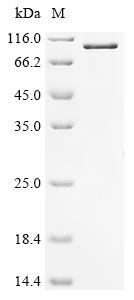

-AC1.jpg)
